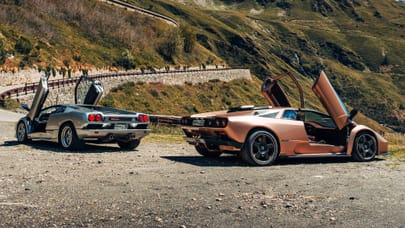
The man who led the Ferrari F40 project has died
Nicola Materazzi - Italy's 'Mr Turbo' and a man who helped shaped the idea of the 'supercar' - dies aged 83
In a business that has its fair share of plus-size egos, TG.com salutes the passing of a man who did more than most to shape the concept of the ‘supercar’ in its formative years, but yet flew determinedly under the radar. Nicola Materazzi, who passed away this week aged 83, will be a familiar figure to anyone with a working knowledge of the Ferrari F40, a towering achievement by any reckoning. But there’s so much more.
Born in Caselle, near Naples, in 1939, he had been a professor at the city’s university before abandoning academia amid the febrile atmosphere of late-Sixties higher education. Lancia offered him a job, and he headed north to Turin, where he worked under the great engineer Francesco De Virgilio. Materazzi was an early and passionate exponent of turbocharging, and helped develop 1977’s outrageous Lancia Stratos Group 5 racer. There was a stint at racing specialist Osella, during which time he worked on a Formula Two car and the wonderful BMW M1 Procar, the one-make Formula One support series that saw many F1 drivers of the day compete.
Then came the call from Enzo Ferrari, who assuaged Materazzi’s concerns about meddling Fiat management by saying he would report to him and him only. In the process, he’d secured the services of Italy’s Mr Turbo, and Materazzi went on to dramatically improve the engine in the 1981 126C F1 car, and generally set the Scuderia on its path to turbocharged success. There were F1 constructor’s titles in 1982 and ’83.
He also oversaw the development of the 288 GTO, originally intended as a Group B racer, but swiftly repurposed as a road car when the FIA cancelled the series following several high profile fatalities and growing safety concerns. Enzo Ferrari was sufficiently motivated by the success the 288 GTO had enjoyed as a road car to commission a successor. That, of course, was the F40, the last car personally signed off by Il Commendatore, and a commercial saviour for the company as it struggled in the aftermath of his death in 1988.
Ferrari intended to manufacture 400, but production exceeded 1,300 units by the end. "I was nervous and reluctant about the F40 proposal because I already had so much work to do," Materazzi recalled in an interview with Wheels magazine. "I only accepted because Enzo allowed me to progress on my own, without wasting time in meetings to share decision-making. At the end of our meeting, he wrote a note in his diary: ‘Materazzi; no pain in the ass.’"
Enzo allowed me to progress on my own, without wasting time in meetings to share decision-making
It was to be a happy project, albeit one done in a very compressed time-frame; the F40, widely regarded as one of Ferrari’s all-time greats, was developed in a little over a year, by a team who worked 24/7. "I remember the first Saturday morning, entering the office at 8am. I thought I would be alone, because I had asked only a few of my team to come in and help… When I arrived my whole team was there waiting for me and excited about the challenge. These were the people who made Ferrari great."
Indeed. Materazzi did not see eye-to-eye with Fiat’s ‘grey men’, as he called them, and decided to quit Ferrari in the late-Eighties. He even resorted to announcing his availability for pastures new in an advertisement in an Italian car magazine. "I was looking for a job in an automotive company – any car company as long as it was not linked with Fiat," he recalled waspishly.
He joined the Cagiva motorbike company, where he managed the racing department, before heading to Bugatti, at owner Romano Artioli’s request, following the departure of Paolo Stanzani. It was Materazzi who insisted on giving the EB110 a carbon fibre chassis, in conjunction with specialist Aerospatiale, to improve its torsional rigidity. He also reworked the engine’s four turbos, although he was never a fan of the solution on the Bugatti (it was a way to "render difficult what is easy by adopting the unnecessary", he noted), and altered the torque distribution front-to-rear to improve the car’s dynamics. The EB110, of course, is now more warmly appreciated than at any time since its launch almost 30 years ago. His final project was the B Engineering Edonis, which was an evolved version of the Bugatti EB110 Super Sport.
An avid reader and bibliophile, Materazzi had amassed a library of 12,000 books, which he enjoyed into his retirement, in his house in Salerno, near Naples. To paraphrase the man himself, he was one of the people who made Ferrari – and the Italian automotive industry – great. TG.com sends its condolences to his friends and family.
Top Gear
Newsletter
Thank you for subscribing to our newsletter. Look out for your regular round-up of news, reviews and offers in your inbox.
Get all the latest news, reviews and exclusives, direct to your inbox.
Trending this week
- Car Review
Honda Civic eHEV








